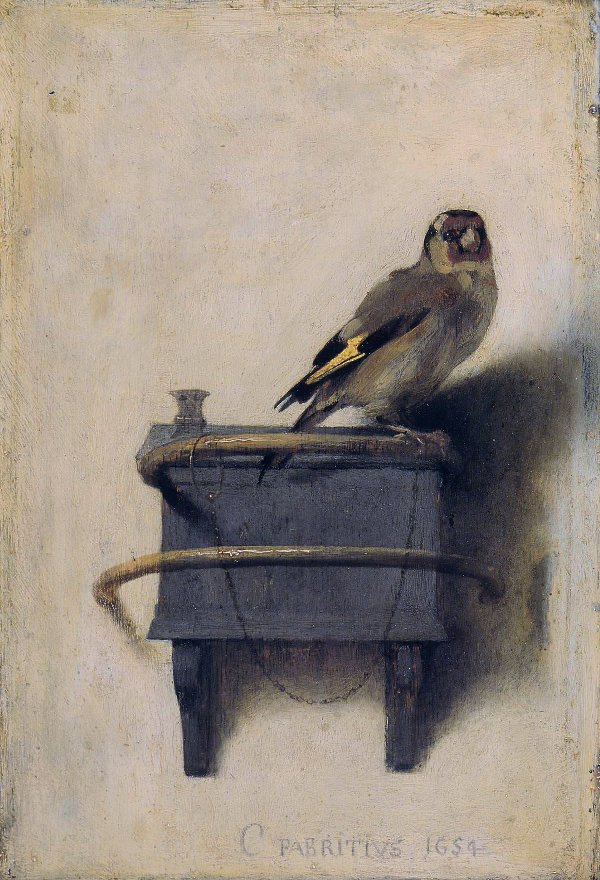The Goldfinch
Carel Fabritius1654
Oil on panel, 33 x 32 cm.
Mauritshuis, The Hague
click here for more Carel Fabritius images

Carel Pietersz. FABRITIUS
Midden Beemster 1622-Delft 1654
Carel Fabritius was a great painter who died young in the explosion of the powder magazine in Delft in 1654 and whose pictures are too rare to perpetuate his reputation. He became a pupil of Rembrandt at an early age and it could be argued that he was the most original painter Rembrandt ever had in his studio. Fabritius appreciated Rembrandt's analytical approach to human character and interpreted it in his own quiet way instead of just imitating the outward bravado of brushwork.
Fabritius has also occupied a peculiar position in the context of the painting style in Delft in the 1650s. This is caused by the fact that the rediscoverer of Vermeer, Thoré-Bürger, who owned Fabritius's Goldfinch, saw Fabritius as a link between Rembrandt and Vermeer. This has led most subsequent writers to see Fabritius as a forerunner of Vermeer and not as a painter in his own right. Indeed, Fabritius was already dead when Vermeer signed and dated his first pictures and they are all more or less derived from Utrecht artists like Hendrick ter Brugghen rather than Fabritius.
Considering how little survives there is a great variety of subject matter and approach in Fabritius's painting. It ranges from the tiny perspective View of Delft the National Gallery, London, to the sleeping sentry or soldier seen against a perfectly painted black wall in the museum at Schwerin. He also painted a small group of heads of old men (in Groningen, Liverpool and The Hague) which almost anticipate Rembrandt's last manner when he also painted so many heads of old men.
Fabritius's palette was richer and softer than that of Vermeer. He preferred very gentle tonal contrasts with no one colour dominating in the way that Vermeer so often used blue or yellow. The details of Fabritius's life are confusing; like his brother Barent he seems to have been in Amsterdam often while continuing to live in Midden Beemster. He was certainly in Delft by 1651 and became a member of the guild there in the following year. His death in the explosion two years later robbed the town of Delft and the whole of Dutch art of one of its greatest painters.
from:
Christopher Wright, The Dutch Painters: 100 Seventeenth Century Masters, London, 1978
- Willem van Aelst (2)
- Balthasar van der Ast (6)
- Hendrick Avercamp (3)
- Dirck van Baburen (7)
- Jacob Adriaenz. Backer (3)
- David Bailly
- Ludolf Bakhuysen
- Bartholomeus van Bassen
- Cornelis Bega
- Gerrit Berckheyde (2)
- Gillis Gillisz de Bergh
- Jan van Bijlert (7)
- Jan de Bisschop (2)
- Abraham Bloemaert (4)
- Pieter De Bloot
- Ferdinand Bol (3)
- Hans Bollinger
- Paulus Bor (2)
- Ambrosio Bosschaert (7)
- Jan Both
- Leonaert Bramer (4)
- Salomon de Bray (2)
- Quiringh van Brekelenkam (4)
- Jan Gerritszoon van Bronchorst (2)
- Adriaen Brouwer (5)
- Hendrick ter Brugghen (6)
- Hendrick van der Burch (5)
- Willem Buytewech (6)
- Abraham van Calraet (2)
- Jacob van Campen
- Jan van de Cappelle(3)
- Pieter Claesz (4)
- Pieter Codde (6)
- Adriaen Coorte (9)
- Josse van Craesbeeck (2)
- Aelbert Cuyp (6)
- Philip van Dijk
- Gerrit Dou (10)
- Willem Drost (2)
- Hendrick Dubbels
- Jacob Duck (4)
- Karel Dujardin (3)
- Willem Duyster (5)
- Gerbrand van den Eeckhout
- Pieter Jansens Elinga
- Cesar van Everdingen (5)
- Allaert van Everdingen
- Carel Fabritius (5)
- Goveart Flinck
- Frans Francken the Younger
- Aert de Gelder
- Cornelis Gijsbrechts
- Jan van Goyen (6)
- Frans Hals (3)
- Dirck Hals (5)
- Jan Davidsz. Heem (6)
- Maerten van Heemskerck
- Bartholomeus van der Helst (4)
- Jan van der Heyden (8)
- Meyndert Hobbema (3)
- Gerard van Honthorst (8)
- Pieter de Hooch (12)
- Van Hoogstraten (9)
- Gerard Houckgeest (4)
- Jan van Huysum (3)
- Willem Kalf (4)
- Jan van Kessel
- Philip Koninck (2)
- Gérard de Lairesse (5)
- Pieter Lastman
- Judith Jansdochter Leyster (5)
- Jan Lievens (4)
- Jacob van Loo (7)
- Nicolaes Maes (9)
- Cornelis de Man (5)
- Gabriel Metsu (12)
- Michiel Janz. van Mierevelt (3)
- Frans van Mieris (8)
- Jan Miense Molenaer (5)
- Pieter Molijn (2)
- Paulus Moreelse (2)
- Pieter Mulier
- Michiel van Musscher (5)
- Aert van der Neer (3)
- Eglon van der Neer (3)
- Caspar Netscher (5)
- Jacob Ochervelt (8)
- Jacob van Oost (2)
- Adriaen van Ostade (5)
- Antonie Palamedesz (6)
- Adam Pijnacker (5)
- Egbert van der Poel (2)
- Jan Porcellis (4)
- Pieter Symonz. Potter
- Paulus Potter (7)
- Pieter Jansz. Quast (2)
- Rembrandt van Rijn (complete oeuvre)
- Jacob van Ruisdael (8)
- Solomon van Ruisdael (7)
- Rachel Ruysch (2)
- Pieter Saenredam (3)
- Godfried Schalcken (6)
- Hercules Segers (2)
- Hendrick Sorg (4)
- Jan Steen (8)
- Harmen Steenwyck (3)
- Matthias Stom (2)
- Michael Sweerts (6)
- David Teniers the Younger
- Gerrit ter Borch (15)
- Willem van de Velde (7)
- Jacob van Velsen
- Johannes Verkolje (2)
- Jan Cornelisz Verspronck (4)
- Abraham de Verwer
- Simon de Vlieger
- Hendrick van Vliet (2)
- Daniel Vosmaer (4)
- Jacobus Vrel (8)
- Jacob van Walscapelle (2)
- Jan Baptist Weenix (2)
- Jan Wijnants (3)
- Emanuel de Witte (6)
- Philips Wouwermans (2)
 or anything else that isn't working as it should be, I'd love to hear it! Please write me at:
or anything else that isn't working as it should be, I'd love to hear it! Please write me at: